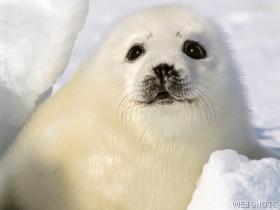ANIMAL ISSUES
By Barry Kent MacKay

Big eyed baby seals. Men swinging heavy clubs. White ice stained crimson.
These are some of the indelible images so ubiquitous in 1970's and 80's, the heyday of the global "save the seals" movement. During those years, animal protection groups from around the world joined forces to fight the wanton slaughter of baby harp and hooded seals that took place each year on Canada's northern ice floes. Pictures from the hunt sparked outrage and, eventually, an measure of reform.
Today, the images are back, more haunting than ever. That's because the Canadian seal hunt is back, bigger and bloodier than before. And animal advocates have come together once again to fight the senseless, barbaric killing.
In truth, the seal hunts never really went away. Although the international outcry sparked by advocacy campaigns of the 70's and 80's resulted in a decline in the number of seals killed in Canada, the hunts were never entirely halted. From 1983 to 1987, an average of 36,000 seals were killed each year in Canada, down from about 300,00 each year during the 1950's. It seemed that a partial victory had been won.
Just recently, activists began once again to shine a spotlight on Canada's northern ice and to expose the horrors of the state-sanctioned seal hunt.
The renewed focus comes on the heels of a 2003 announcement by the Canadian government that it would permit the clubbing and shooting of close to one million baby harp seals over the next three years, the highest quota for seal killing in Canada's history, and the largest commercial kill of marine mammals in the world. The government claims that the "culling" of seals is necessary in order to save the imperiled cod. They charge that the seals eat "too many fish," while failing to acknowledge the true cause of precipitous decline in cod populations: over fishing by humans.
Although killing seals won't bring back the cod, the commercial seal hunt continues to be promoted and subsidized by the Canadian government. It is a bloody business.
On April 5, 2004, the New York Times described how hunters bear down on helpless seal pups, "with one or two blows to the head, they crush the skulls, sometimes leaving the young animals in convulsions." This year's hunt has already resulted in the deaths of over 320,000 seals, most of who were between the ages of twelve days and three months old.
In the current hunt, most seals are shot, rather than clubbed (older seals are difficult to reach and club on ice floes). Hunters, however, prefer clubbing to shooting, not only to save the cost of bullets, but because pelts containing bullet holes command lower prices on the fur market.
Neither shooting nor clubbing is a humane form of killing. Many animals who are shot are not immediately killed, but are wounded. Some wounded animals escape into The sea, then die beneath the ice. Others are dragged aboard boats to be active in encouraging US Senators to pass S. Res 269, a resolution condemning the massacre. As part of the International Fur-Free Alliance, we've helped push for bans on the importation of seal pelts, including the ban on the import and trading of seal fur recently adopted by Belgium. API was also one of the many groups that helped raise public awareness of the slaughter by joining graphic advertisements in publications such as the New York Times.
You, too, can speak up for the seals! Contact your two US Senators, and ask them to sign on to S. Res. 269, condemning the Canadian seal massacre. You can look up the names of your US Senators at www.Congress.org, and you can contact them by calling (202) 224-3121 or writing to: The Honorable (Full Name); US Senate, Washington, D.C. 20510.
You can also let the Canadian Tourism Commission know that you'll vacation elsewhere. E-mail its members at www.travelcanada.ca.
In addition, tell Canadian public officials that you think the seal hunt is unnecessary and inhumane. Send your comments to: Ambassador Michael F. Kergin; Canadian Embassy; 501 Pennsylvania Ave., NW; Washington, DC 20001; (202) 682-1740; FAX (202) 682 7678.
Fall 2004 Issue |











